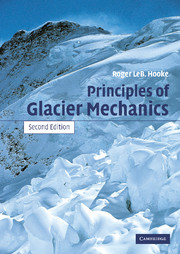Book contents
- Frontmatter
- Contents
- Preface to the first edition
- Preface to the second edition
- Physical constants relevant to ice
- Derived SI units and conversion factors
- 1 Why study glaciers?
- 2 Some basic concepts
- 3 Mass balance
- 4 Flow and fracture of a crystalline material
- 5 The velocity field in a glacier
- 6 Temperature distribution in polar ice sheets
- 7 The coupling between a glacier and its bed
- 8 Water flow in and under glaciers: geomorphic implications
- 9 Stress and deformation
- 10 Stress and velocity distribution in an idealized glacier
- 11 Numerical modeling
- 12 Applications of stress and deformation principles to classical problems
- 13 Finite strain and the origin of foliation
- 14 Response of glaciers to changes in mass balance
- Appendix: Problems
- References
- Index
8 - Water flow in and under glaciers: geomorphic implications
Published online by Cambridge University Press: 24 November 2009
- Frontmatter
- Contents
- Preface to the first edition
- Preface to the second edition
- Physical constants relevant to ice
- Derived SI units and conversion factors
- 1 Why study glaciers?
- 2 Some basic concepts
- 3 Mass balance
- 4 Flow and fracture of a crystalline material
- 5 The velocity field in a glacier
- 6 Temperature distribution in polar ice sheets
- 7 The coupling between a glacier and its bed
- 8 Water flow in and under glaciers: geomorphic implications
- 9 Stress and deformation
- 10 Stress and velocity distribution in an idealized glacier
- 11 Numerical modeling
- 12 Applications of stress and deformation principles to classical problems
- 13 Finite strain and the origin of foliation
- 14 Response of glaciers to changes in mass balance
- Appendix: Problems
- References
- Index
Summary
A great deal has been learned about water flow through glaciers in the past three decades. Much of the progress has been theoretical, as experimental techniques for studying the englacial and subglacial hydraulic systems are few and not yet fully exploited, and observational evidence is difficult to obtain for obvious reasons. An added benefit of the recent progress is that we have gained a much better understanding of glacial erosional processes and of the origin of certain glacial landforms that owe their existence to the interaction between water and ice.
We begin this chapter with a discussion of the development and geometry of englacial water conduits in temperate glaciers. Then, the subglacial part of the system is examined. Finally, we consider geomorphic implications of some of the recent research.
The upper part of the englacial hydraulic system
Veins and the initial development of passages
Nye and Frank (1973) argued that veins should be present along boundaries where three ice crystals meet, and that at four-grain intersections these veins should join to form a network of capillary-sized tubes through which water can move. They thus concluded that temperate ice should be permeable.
Such capillary passages have been observed in ice cores obtained from depths of up to 60 m on Blue Glacier, Washington (Figure 8.1a) (Raymond and Harrison, 1975). The veins are triangular in shape (Figure 8.1b) and roughly 25 μm across.
Estimates of the permeability of glacier ice resulting from this vein system vary widely.
- Type
- Chapter
- Information
- Principles of Glacier Mechanics , pp. 197 - 251Publisher: Cambridge University PressPrint publication year: 2005



